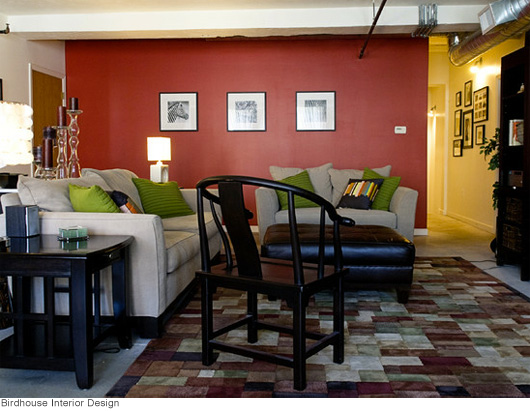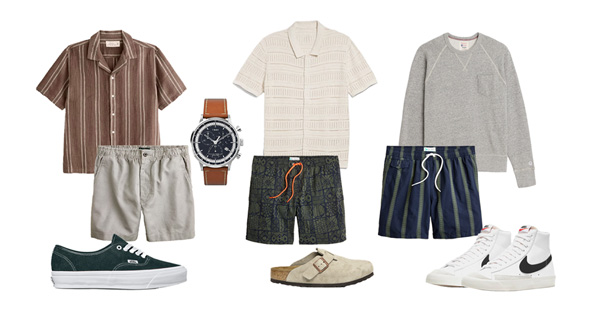I have a belief: that when you get home at the end of the day, your place should say ‘hello' to you. If it's not, it has laryngitis. This means your place lacks personality, uniqueness, a voice.
Since prehistoric times, men have been unfairly associated with a brutish disinterest in ‘interior decorating'. This may have to do with the term itself. With its perfumy, noxious odor, it's pushed us away, forcing good men to rebel by clinging to tried and true vestiges of their primordial past – the well-worn La-Z-Boy and surrealistic design appointments, such as empty pizza boxes and Budweiser cans. Time to replace ‘decorating' with ‘design.' Can you feel the difference?
There's also the obvious evolutionary argument: we were out hunting and fending off dinosaurs, so we didn't have time to devote to window trim and floral arrangement. But, times have changed. What's more, we're beyond the 70's bachelor pad days of sunken living rooms, water beds, and ill-proportioned faux Italian sofas. D-O-N-E. Welcome to 2012, where style conscious males are eager to give new definition to the cliché, ‘A man's home is his castle'. The challenge now for urban dwellers is to find inventive ways of giving their place personality, while still honoring financial considerations, limited time, and space restrictions.
Consider, for a moment, that space is a sacred thing – ‘sacred' in that it provides the container in which we live our lives, but also in that it allows us to imbue our environment with as much or little of ourselves as we please. As with fashion or art, our home offers an opportunity to show the world who we are, express our identity. It's a canvas inviting our signature.
So, let's look at 5 ideas to help make your place a little more, beguiling:
Color
One way of injecting your place with a quick dose of personality and mood is through the use of color. It's generally known that certain colors correspond to certain moods. Light colors tend to be expansive and airy, making rooms feel brighter, cheerier.
Kitchens and bathrooms typically do well with light colors, as they're spaces where we like an enthusiastic ‘good morning.' Dark colors, sophisticated and warm, offer depth and intimacy. Perhaps a furtive plum in the living room – very theatrical. How about making a strong first impression in the entryway with a rich, yet punchy red? Greens, restful for the eye (while also associated with fertility), do well in bedrooms. Balance big personality colors with complex neutrals, lending quiet understatement. Accent walls permit splashes of personality, but also restraint. Bottom line, though; do what moves or inspires you – via color.
Mixing Old and New
Some like modern; others, antique. But, juxtaposing the two creates visual interest and seductive tension. Say you have a 1930s mahogany side table from your grandmother. Nice, but arguably heavy and certainly dated. Create synergy by adding a sleek sculptural reading lamp there. That way, you have the history offered by the table, but it's balanced by an object that's lighter, hipper, and unexpected. Traditional dining table? Counter with acrylic dining chairs. Modern living room? Temper with a warm Persian rug (or reproduction).
Got some cool, splashy wallpaper on the wall? How about hanging one of those old portrait paintings there? You get the idea. Balance. Layering time periods stimulates the senses, defying the norm and extracting inspiration from different times. That's cool.
Vintage Charm
New objects can be beautiful, but ‘old' ones offer authenticity, soul. They're also less demanding on the wallet, usually. Poking around in flea markets, consignment shops, city stores (many cities have stores where they sell their old municipal equipment), and mid-century furniture galleries, can generate one-of-a-kind finds. Making them work in your place encourages creativity and delivers an effect that is fun, sexy, and chic. So, you get your hands on a 1940's detective's office stainless steel file cabinet. Why not use it as a bedside table?
Re-purposing things in inventive ways creates intrigue. Short on closet space? An antique industrial garment rack avoids contractor fees. Need kitchen supplies for your new place? There's always Bed, Bath, and Beyonce, but why not go industrial with some cool professional grade accouterments from a restaurant supply store? How about a vintage picnic table as ‘dining table'? Or, an old municipal ‘Men Working‘ sign for your home office. Be creative by reaching to the past to find things that speak to you and incorporate them into your living space, your life.
Break Rules, (skilfully)
“Rules are made to be broken.” This is equally true in interior design.
Let's reconsider some basic design myths:
Rule #1: Things must match.
Consistency and order have their place in space planning, but too much yields boredom and predictability. Take color; juxtaposing colors that contrast with one another (but still work together) creates synergy and excitement. Same with matching furniture. What if instead of matching dining chairs, you had an eclectic mix – some vintage office chairs, a Louis IX-like dining chair, something modern, maybe even a wicker bench or stool? Have fun by layering periods, styles, textures, colors, and patterns, infusing your environment with multiple flavors and eye candy pause. ‘Conflict' is interesting.
Rule #2: Your living room needs a sofa.
Not really. Do the unexpected by putting a couple of beautiful tobacco colored lounge chairs there instead, saving space and providing intrigue. Reinforce the choice by situating chairs asymmetrically, perhaps alongside a cute rug (zebra?) and offbeat end table (old tavern stool?) Not everything need be straight or flush against the wall. Beauty can supersede practicality.
Rule #3: Treat some rooms better than others.
Why, when we spend 182 hours a year there, has the bathroom been forever viewed as the home's red haired stepchild? (Well, obviously, but still.) Show the bathroom some love with a surprisingly tasteful piece of wall art or by displaying a faux Roman bust on the vanity. Perky towels and innovative shower curtain design deliver added punch and say ‘every room's important.'
Rule #4: Rooms have only 1 purpose.
Not so. Bring library like flavor into the kitchen by creating a little reading nook with some earthy but appealing books displayed on a simple shelf. Maybe an area rug. This gives added intimacy to the kitchen (and allows bibliophiles and gastronomes to unite.) Similarly, an aged velvet love seat provides additional seating in a bedroom and lends nuance to the space.
Rule #5: You don't paint the ceiling.
Why not? The ceiling is the fifth wall in the house. Painting it can look beautiful, emboldening your place and allowing the eye to travel up in wonder, as in the Sistine Chapel (well, you get the point.)
Less is More
We live in an age of overload and alongside a pastime that insists, “the more, the better.” “All you can eat.” In interior design, this means randomly filling space. It means clutter. In space planning, one cannot overemphasize the aesthetic value of understatement, restraint. Approach design with an editorial eye. Emphasize quality over quantity in purchases. With furniture placement, one beautiful chair trumps two dowdy looking ones. Stuff strewn around? Conceal it, revealing a leaner, lighter environment. Use colors that beget simplicity. Seek out natural materials that engender an organic warmth. Highlight architectural details (exposed brick, beams), allowing their inherent beauty to compliment your space. And, eliminate the unnecessary – do you really need an area rug there or can the parquet floors speak for themselves? Sometimes minimalism is the best.
Period.




















